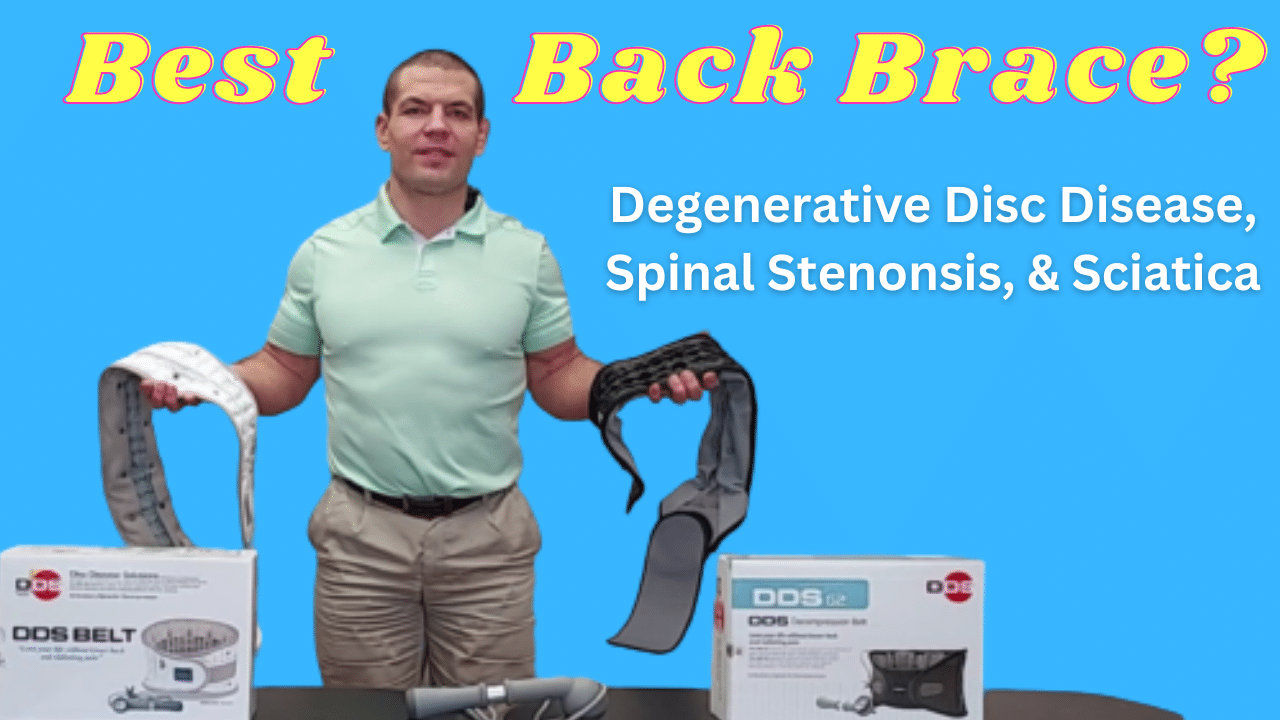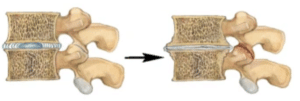Looking For A Best Back Brace For Degenerative Disc Disease, Spinal Stenosis, and Sciatica?
Back braces are rarely a complete solution for any type of back problem, but they can help relieve symptoms.
There are many different types of back braces that are marketed toward people with degenerative disc disease, spinal stenosis, and sciatica because those are super common problems.
So there's a lot of money at stake in the back brace industry. People invest a lot of money in EXPENSIVE marketers and copywriters to make you want to buy their back brace.
However, most back braces DON'T do a lot to address the underlying factor that causes pain in degenerative disc disease, spinal stenosis, and sciatica.
So in this post, I'm going to give you an unbiased review of back braces for degenerative disc disease, spinal stenosis, and sciatica.
For full disclosure, all of the links to back braces in this post are affiliate links, so I will earn a small commission if you buy something through these links, but I don't care which one you buy, or if you buy one at all.
I'm giving you my true, honest opinion based on my experience seeing patients use many different types of back braces.
So What's My Choice for The Best Back Brace For Degenerative Degenerative Disc Disease, Spinal Stenosis, And Sciatica?
My top choices are the is the DDS 300 Back Decompression Brace and the G2 Back Decompression Brace.
Both braces are made by Disc Disease Solutions. You can SAVE 10% at the DDS Store by using my discount code "DRCANDY10" at checkout.
Why Are These My Top Choices?
As I mentioned, most back braces on the market don't address the underlying factor that causes pain in degenerative disc disease, spinal stenosis, and sciatica.
And that factor is COMPRESSION.
Why Does Compression Affect Degenerative Disc Disease, Spinal Stenosis, and Sciatica?
Well, as you age, the discs between your vertebrae dry out and lose height.
That's why people get a little shorter as they age.
Normally, that's not a big deal, but as you lose disc height, the joints in the vertebrae get closer together.
If you have arthritis in your spine (also known as "spondylosis" or "degenerative joint disease"), the loss of height causes the arthritic joint surfaces in your facet joints to rub together.
Additionally, as you lose disc height, the spaces where your nerve roots exit the spine (the intervertebral foramen) also get smaller.
That narrowing of the spaces between your spine is called spinal stenosis.
If the stenosis gets severe enough, it can start to pinch the nerve roots that exit your lower back causing sciatica - or nerve pain that's referred down the back of the leg.
Why Don't Most Back Braces Affect Compression?
Most back braces are essentially corsets. They cause circumferential compression around your spine.
They're designed to act like your abdominal muscles and increase your core stability.
They can help if you have an unstable spine, but they don't do anything to address the vertical compression from gravity.
Gravity pushes down on you all day and compresses your spine.
That's why you're tallest in the morning and shortest at the end of the day... because gravity has been pushing down on you all day long and compressing your spine.
That means that symptoms of degenerative disc disease, spinal stenosis, and sciatica can get worse later in the day, particularly if you've been on your feet for long periods of time.
In fact, the chief complaint of people with degenerative disc disease and spinal stenosis is standing or walking for long periods of time.
How Does The DDS 300 Back Brace Help Compression?
The DDS 300 brace, as the name implies, was designed for degenerative disc disease.
It has vertical air columns that inflate using a hand pump.
You put the brace on tight like a normal back brace but then instead of adding extra compression by pulling cords or velcroing a seconds set of straps, this brace lifts your up vertically.
It DECOMPRESSES your vertebrae.
It works sort of like a traction or decompression table at chiropractor or physical therapists office, except that you can walk around in it.
The bad part about traction tables is that when you stand up, gravity recompresses your spine and any benefit that you gained from traction quickly goes away.
And sometimes it can cause a REBOUND EFFECT, where your pain worsens due to reloading your joints and your nerves too quickly.
But the DDS 300 back brace allows you to walk around in traction, giving you relieve from back pain and sciatica at the times that the back pain bothers you the most... when standing and walking.
How Does The DDS G2 Back Brace Help Compression?
The G2 works by the same mechanism as the DDS 300.
There area few differences between the DDS 300 and and G2 though.
What Are The Differences Between The DDS 300 And The G2?
The DDS 300 is the original back decompression brace made by Disc Disease Solutions. It has a fairly standard width from front to back whereas the G2 is narrower in front and taller in back.
The DDS 300 is a little thinner and more streamlined than the G2, making the DDS perhaps a better choice for shorter people, whereas the G2 may be better for taller people.
Both the DDS 300 and the G2 are available in multiple sizes. However, the G2 has double Velcro straps in front making it more adjustable within a certain size range. This would be helpful if you're sharing one brace between two different family members.
The G2 does have a lower price point than the original DDS 300 at least at the time of publishing this article.
When I tried both braces on, I did find the DDS 300 to be more comfortable for me personally, but that was due to the streamlined shape.
It fit between my pelvis and ribcage better than the G2 did and felt more comfortable when I inflated it.
However, that was just my experience. Watch the video at the top of the page for a comparison of the two braces.
What What Other Back Braces Are Good For Degenerative Disc Disease, Spinal Stenosis, and Sciatica?
Largely, any other brace that I'd recommend would work by the same principle.
There are several generic back braces that work by the same concept as the DDS 300 and come with a lower price tag.
I have had feedback from some patients that if they use these cheaper models for awhile, the air columns eventually start to leak.
You can see the direct comparison between the two in the video below.
Note: This video was made by DDS, so it is likely biased toward their products, but you can at least see a side-by-side comparison.
This is the Dr. Ho Back Decompression Belt from the video above.
They work OK for short-term needs. They are a little more bulky than the DDS brand braces. Additionally, as you can see from the picture, there is no pressure gauge on he pump.
However, if you just need a back brace for a short period of time while your working on a longer lasting solution for your degenerative disc disease, spinal stenosis, or sciatica, then these braces are a good option to get you some relief on a budget.
I would still recommend these braces over "standard" back braces that don't inflate at all.
Frequently Asked Questions About Back Braces
Is a back brace good for degenerative disc disease?
Back braces can be a helpful tool for managing the pain and discomfort associated with degenerative disc disease. However, they should not be used as the sole treatment for this condition. You should address your posture, muscle imbalances, strength deficits, and flexibility deficits as well.
Getting the right treatment for degenerative disc disease can maximize the amount of space that you do have between your vertebrae and help keep you from becoming overly dependent on wearing a back brace.
Should I wear a back brace for spinal stenosis?
Much the same as with degenerative disc disease, back braces can help with spinal stenosis but they shouldn't be the sole treatment.
Wearing a lumbar decompression brace like the ones mentioned above though can help you walk longer.
And walking is one of the best exercises for spinal stenosis.
Unfortunately, many people with spinal stenosis also experience walking problems.
By wearing a back brace that allows you to walk more, you can increase the blood flow and oxygen that's getting to your nerves.
Does a back brace help with sciatica?
Back braces help with some types of sciatica.
Sciatica is just a term referring to pain in the buttock and back of the leg. That may be caused by the nerve roots in your lower back that make up the sciatic nerve.
A back brace can help relieve symptoms from that type of sciatica.
However, if your sciatic nerve is being compressed due to piriformis syndrome at the hip, then wearing a back brace won't help that type of sciatica.
How Often Should I Use The Disc Disease Solutions Back Brace?
You should NOT wear the back brace all the time. In fact, decompression back braces are most effective when you wear them standing and walking.
They're not as helpful when you're sitting.
But most people with degenerative disc disease, spinal stenosis, and back-related sciatica don't have a lot of pain when they're sitting.
So I recommend using the Disc Disease Solutions brace only when you're planning on standing or walking for long periods of time.
This may include:
- Going to the gym
- Walking your dog
- Going to the store
- Cooking dinner
- Doing household chores like vacuuming
How Do I Use The Disc Disease Solutions Back Brace?
Start by putting the brace around your waist between your pelvis and your ribcage
Fasten the Velcro on the brace tight enough that the brace is snug and won't slip.
Next attach the hand pump to the valve on the brace.
Pump up the brace using the hand pump to a comfortable level.
Then disconnect the pump, and you're good to go be active.
Make sure to reattach the pump and deflate the brace before taking it off in order to maximize the lifetime of the brace.
Conclusion
Wearing a back brace can help degenerative disc disease, spinal stenosis, and sciatica.
If you want the BEST brace brace for degenerative disc disease, spinal stenosis, and sciatica, I'd recommend the DDS 300 Back Decompression Brace or the G2 Back Decompression Brace.
If you would like to buy either of those braces to help your spinal stenosis, degenerative disc disease, or sciatica, I've arranged a 10% Discount Code with the Disc Disease Solutions for you when you purchase the brace through their website and enter the code "DRCANDY10" at checkout.
Need More Help For Back Pain or Sciatica?
If you're in St. Louis, tap the button below to request a Free Consultation with one of our specialists.
If you're outside of St. Louis but still need help for back pain or sciatica, click here to learn about my online Relieve Sciatic Nerve Pain At Home Course.





